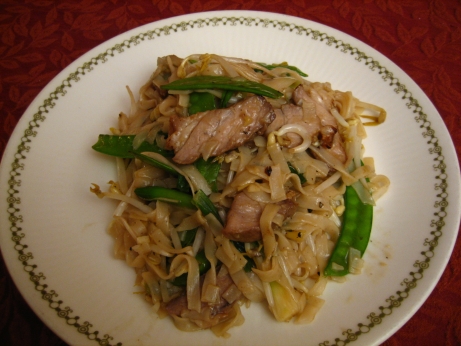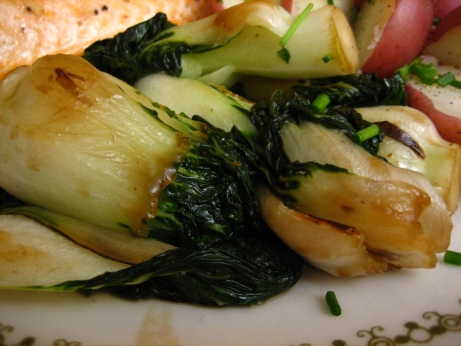
The recipe.
This is the stir fry I mentioned a while back. It called for leftover Char Siu as an ingredient. The stir fry alone is competent, but not exceptional. The char siu is what makes the dish. The stir fry is very restrained in it’s selection of vegetables, just snow peats, scallions, and bean sprouts. This is cooked up with rice noodles, and the char siu. The flavourings are a fairly standard combination of chicken stock, oyster sauce, soy, sake, sugar, garlic, ginger, and sesame oil. All good stuff, nothing hard to find, and quite well balanced. This stir fry is the closest to Chinese take-out I’ve ever made at home. I’ve made stir fries I’ve liked better, but this was the most authentic if you’ll permit me to stretch that word to it’s breaking point.
The cooking directions seem a bit backwards to me. The recipe fries the noodles in the wok first, then adds the vegetables and aromatics and sauces. One of my favourite things about stir fry is the way the vegetables get seared on the outside, but remain crisp inside. In this method the noodles prevent the veg from ever really making contact with the bottom of the wok, so they end up steamed. That’s not so bad, but I missed the caramelization.
Once the frying is done the stock, oyster sauce, soy, sake, sugar mixture is added, boiled and thickened with corn starch. This did a great job of producing that take-out style slick glossy texture, and made them more fun to eat.
I was a bit surprised to see that the recipe called for a wok. Home wokery seems to have fallen out of favour in the last decade or so (Cook’s illustrated would have us throw them out). The objection is that wok cooking is an extremely high heat cooking method, and that our ranges (even top of the line gas burners) can’t pump out the BTUs necessary to do the technique justice. I’ve seen Alton Brown get around this by setting a round bottomed wok on the industrial sized burner of a turkey deep-fryer, or over a charcoal chimney starter. I have a large round-bottomed stain-prone steel wok that I enjoy cooking with on my electric burner, even if it doesn’t have the benediction of Chris Kimball. I like the size and shape more than its heat distribution properties. I enjoy having room to move the food around without slopping things over the sides. I’m a fan of my wok, but I’ve felt like it was my dirty little secret. It’s nice to see The Book validate my cooking lifestyle choice.
If you have Char Siu in the freezer this recipe takes 20 minutes, and tastes great. I’d like to have a control condition stir fry though. I feel like the Char Siu recipe was so good it could make any stir fry delicious. However, if you’re feeling like DIY take-out food this dish is the way to go.

